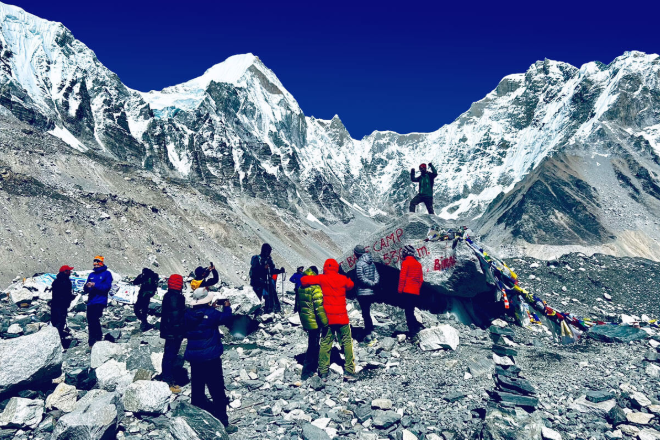Introduction
The Everest Base Camp trek stands as one of the world’s most iconic adventures, drawing thousands of trekkers annually to Nepal’s Khumbu region. This legendary journey takes adventurers through breathtaking Himalayan landscapes, charming Sherpa villages, and ultimately to the base of the world’s highest peak—Mount Everest. Standing at the foot of this magnificent mountain at 5,364 meters (17,598 feet) above sea level offers an incomparable sense of achievement and awe that few other trekking destinations can match.
The Allure of Everest Base Camp
What makes the Everest Base Camp trek so exceptional is its perfect blend of natural splendor, cultural richness, and physical challenge. The route winds through the stunning Sagarmatha National Park, a UNESCO World Heritage site renowned for its dramatic peaks, deep valleys, and diverse flora and fauna. Along the way, trekkers have opportunities to immerse themselves in Sherpa culture, visit ancient Buddhist monasteries, and experience the legendary hospitality of the mountain communities.
The journey is challenging yet accessible for reasonably fit individuals. Unlike summit expeditions, the trek requires no technical climbing skills, making it attainable for enthusiastic hikers who prepare adequately. This accessibility, combined with the undeniable allure of Everest, explains why this trek continues to occupy the bucket lists of adventure seekers worldwide.
Everest Base Camp Trek Cost Breakdown
Understanding the financial aspects of the Everest Base Camp trek Cost is crucial for proper planning. Costs vary significantly based on multiple factors, including trekking style, season, and personal preferences. Here’s a comprehensive breakdown:
Package Tours vs. Independent Trekking
Package Tours: Most trekkers opt for all-inclusive packages ranging from $1,200 to $4,000. These typically cover:
- Airport transfers
- Domestic flights to/from Lukla
- Accommodation throughout the trek
- Three meals daily
- Professional guide and porters
- Permits and entrance fees
- Some trekking equipment
Independent Trekking: Budget-conscious adventurers might spend $700-1,500 by:
- Arranging transportation independently
- Booking teahouses directly
- Hiring a guide/porter separately or trekking solo (though not recommended for first-timers)
- Managing permits independently
Essential Expenses
Permits: Two permits are mandatory:
- Sagarmatha National Park Entry Permit: $30
- Khumbu Pasang Lhamu Rural Municipality Entrance Fee: $20
Flights: The Kathmandu to Lukla flight (the standard starting point) costs $180-220 each way, depending on season and availability.
Accommodation: Teahouse lodges charge $5-20 per night, with prices increasing with altitude and decreasing comfort.
Food and Beverages: Daily food costs range from $25-40, with prices rising significantly at higher elevations. Water purification options can save considerable money over purchasing bottled water.
Guide and Porter Fees:
- Licensed guide: $25-35 daily
- Porter: $20-25 daily (typically carries up to 15kg)
Additional Costs
- Travel insurance with high-altitude and helicopter evacuation coverage: $100-200
- Equipment rental or purchase: $200-500 (quality sleeping bag, down jacket, trekking poles, etc.)
- Personal expenses, snacks, hot showers, device charging: $10-15 daily
- Tips for guides and porters: 10-15% of total service cost
- Contingency funds: $200-300 recommended
Seasonal Cost Variations
The peak seasons (March-May and September-November) command premium prices due to optimal weather conditions. Trekking during the off-season (December-February and June-August) can reduce costs by 20-30%, though weather challenges and limited services should be expected.
Everest Base Camp Trek Itinerary
A well-planned Everest Base Camp Trek itinerary is crucial for acclimatization and enjoyment. The standard route spans 12-14 days, though variations exist. Here’s a classic 14-day itinerary:
Day 1: Arrival in Kathmandu (1,400m)
Orientation, equipment check, permit acquisition, and cultural exploration in Nepal’s vibrant capital.
Day 2: Fly to Lukla (2,860m) and Trek to Phakding (2,610m)
The adventure begins with the exhilarating flight to Lukla’s mountain airstrip, followed by a gentle 3-4 hour downhill and flat trek to Phakding along the Dudh Koshi River.
Day 3: Phakding to Namche Bazaar (3,440m)
A challenging 6-7 hour day crossing suspension bridges, including the famous Hillary Bridge, and ascending steeply to reach the bustling hub of Namche Bazaar—the gateway to the high Himalayas.
Day 4: Acclimatization Day in Namche Bazaar
A crucial rest day featuring a short hike to the Everest View Hotel (3,880m) for your first glimpse of Everest, then exploring Namche’s markets and cultural attractions.
Day 5: Namche Bazaar to Tengboche (3,860m)
A 5-6 hour trek through rhododendron forests to Tengboche, home to the largest monastery in the region, offering spectacular panoramic mountain views.
Day 6: Tengboche to Dingboche (4,410m)
A 5-6 hour journey crossing the treeline into alpine terrain, with magnificent views of Ama Dablam mountain.
Day 7: Acclimatization Day in Dingboche
Another essential acclimatization day with a short climb to nearby ridges for stunning views of Island Peak and the Chukhung Valley.
Day 8: Dingboche to Lobuche (4,940m)
A 5-6 hour trek through the dramatic Khumbu Valley, passing memorials to climbers who perished on Everest.
Day 9: Lobuche to Gorak Shep (5,170m) and Everest Base Camp (5,364m)
The pinnacle day involves reaching Gorak Shep before undertaking the final push to Everest Base Camp—totaling 7-8 hours of challenging trekking at high altitude.
Day 10: Hike to Kala Patthar (5,545m) and Descend to Pheriche (4,240m)
An early morning ascent of Kala Patthar for sunrise views of Everest, followed by a long descent to Pheriche.
Day 11: Pheriche to Namche Bazaar (3,440m)
A long day of mostly downhill trekking, retracing steps through now-familiar terrain.
Day 12: Namche Bazaar to Lukla (2,860m)
The final day of trekking concludes the circuit back at Lukla.
Day 13: Fly from Lukla to Kathmandu
Weather permitting, return to Kathmandu for celebration and relaxation.
Day 14: Departure Day
Final shopping, cultural activities, and departure from Nepal.
Essential Preparation Tips
Physical Conditioning
Begin cardio and strength training 3-4 months before departure, focusing on hiking with a pack, stair climbing, and leg strengthening exercises.
Altitude Adaptation
Follow the recommended itinerary’s acclimatization days strictly. Consider medications like Diamox after consulting your doctor, but recognize that proper acclimatization remains the key safeguard.
Equipment Essentials
Invest in quality layered clothing, sturdy boots (broken in before the trek), a warm sleeping bag rated for -10°C, and comprehensive personal medical supplies.
Weather Considerations
Spring (March-May) offers warm temperatures and rhododendron blooms, while autumn (September-November) provides the clearest mountain views. Winter treks (December-February) face extreme cold but fewer crowds, and summer expeditions (June-August) contend with monsoon conditions.
Conclusion
The Everest Base Camp trek represents far more than a mere hiking expedition—it’s a profound journey through breathtaking landscapes and rich cultural heritage that culminates in standing before the world’s highest mountain. While demanding both physically and mentally, proper preparation and realistic expectations make this adventure accessible to determined trekkers from various backgrounds and fitness levels.
Whether you choose a guided package or independent adventure, the memories formed along this legendary path—from sunrise panoramas illuminating snow-capped peaks to warm interactions with Sherpa communities—will undoubtedly become treasured lifetime experiences. The journey to Everest Base Camp offers not just magnificent vistas, but also invaluable lessons in perseverance, cultural appreciation, and our humble place amid nature’s grandest expressions.

